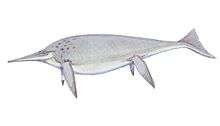Himalayasaurus
Himalayasaurus is an extinct genus of ichthyosaur from the Late Triassic of Tibet. The type species Himalayasaurus tibetensis was described in 1972 on the basis of fragmentary remains, including teeth, limb bones, and vertebrae. The entire body length of Himalayasaurus is estimated to have been over 15 metres (49 ft) in length.[2] Himalayasaurus has since been considered a nomen dubium or "dubious name" because of the lack of features that set it apart from other ichthyosaurs,[3] although the presence of distinct cutting edges on its teeth have more recently been proposed as a unique feature of the genus (cutting edges have also been found in the recently described ichthyosaur Thalattoarchon from the western United States).[4] Himalayasaurus belongs to the family Shastasauridae, which includes other large-bodied Triassic ichthyosaurs like Shonisaurus.[2]
| Himalayasaurus | |
|---|---|
| Scientific classification | |
| Kingdom: | Animalia |
| Phylum: | Chordata |
| Class: | Reptilia |
| Order: | †Ichthyosauria |
| Family: | †Shastasauridae |
| Genus: | †Himalayasaurus Dong, 1972 |
| Type species | |
| †Himalayasaurus tibetensis Dong, 1972 | |
See also
- List of ichthyosaurs
- Timeline of ichthyosaur research
References
- "†Himalayasaurus Dong 1972 (ichthyosaur)". Paleobiology Database. Fossilworks. Retrieved 11 August 2017.
- Motani, R.; Manabe, M.; Dong, Z.-M. (1999). "The status of Himalayasaurus tibetensis (Ichthyopterygia)" (PDF). Paludicola. 2 (2): 174–181. Archived from the original (PDF) on 2016-03-05. Retrieved 2013-01-07.
- Lucas, S.G.; González-León, C.M. (1995). "Ichthyosaurs from the Upper Triassic of Sonora and the biochronology of Triassic ichthyosaurs". Geological Society of America Special Papers. 301: 17–20.
- Fröbischa, N. B.; Fröbischa, J. R.; Sanderb, P. M.; Schmitzc, L.; Rieppeld, O. (2013). "Macropredatory ichthyosaur from the Middle Triassic and the origin of modern trophic networks". Proceedings of the National Academy of Sciences. 110: 1393–1397. doi:10.1073/pnas.1216750110. PMC 3557033. PMID 23297200.

